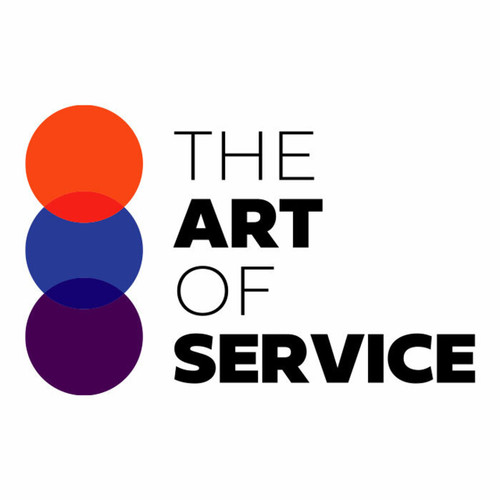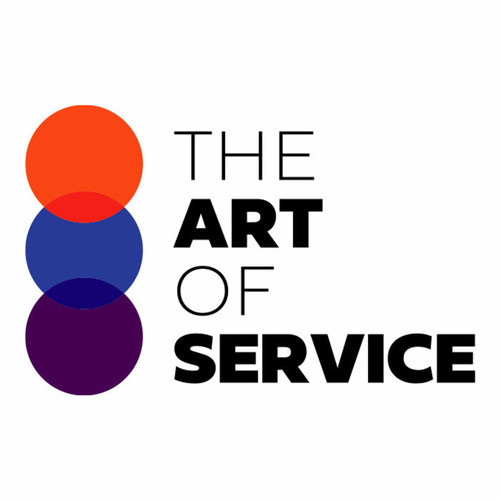Want to improve your online performance and increase sales? Look no further than our Refund Rates and E-Commerce Analytics knowledge base.
With over 1500 prioritized requirements, solutions, and benefits, our dataset provides you with all the necessary tools to understand and improve your e-commerce performance.
Our carefully curated list of questions will help you identify urgent issues and provide solutions to improve your sales and reduce refund rates.
We know how valuable your time is, that′s why we′ve prioritized the most important questions for your convenience.
But what truly sets us apart from competitors and alternatives? Our Refund Rates and E-Commerce Analytics knowledge base is specifically designed for professionals like you.
No matter what product or service you offer, our dataset can be easily used to analyze and improve your e-commerce performance.
And for those on a budget, our knowledge base is DIY and affordable, making it the perfect solution for small businesses and entrepreneurs.
Still not convinced? Let our robust dataset do the talking.
Our product details and specifications overview give you a clear understanding of how to use our knowledge base effectively.
Plus, we even include real-life case studies and use-cases to showcase the tangible results our product can bring to your business.
We understand the importance of data and its impact on your e-commerce success.
That′s why we′ve done extensive research to ensure our knowledge base covers all aspects of e-commerce performance.
From reducing refund rates to improving customer satisfaction, our dataset has got you covered.
Our Refund Rates and E-Commerce Analytics knowledge base is not just limited to businesses, it′s also useful for individuals looking to enhance their online presence and sales.
With our cost-effective pricing, our knowledge base is accessible for everyone.
But wait, that′s not all!
We also provide you with the pros and cons of using our knowledge base so you can make an informed decision.
And let′s not forget, our product provides a comprehensive explanation of what it does and how it can benefit you.
So why wait? Take the first step towards improving your e-commerce performance and increasing sales.
Get our Refund Rates and E-Commerce Analytics knowledge base today and see the results for yourself!
Discover Insights, Make Informed Decisions, and Stay Ahead of the Curve:
Key Features:
Comprehensive set of 1544 prioritized Refund Rates requirements. - Extensive coverage of 85 Refund Rates topic scopes.
- In-depth analysis of 85 Refund Rates step-by-step solutions, benefits, BHAGs.
- Detailed examination of 85 Refund Rates case studies and use cases.
- Digital download upon purchase.
- Enjoy lifetime document updates included with your purchase.
- Benefit from a fully editable and customizable Excel format.
- Trusted and utilized by over 10,000 organizations.
- Covering: DataOps Case Studies, Page Views, Marketing Campaigns, Data Integration, Big Data, Data Modeling, Traffic Sources, Data Observability, Data Architecture, Behavioral Analytics, Data Mining, Data Culture, Churn Rates, Product Affinity, Abandoned Carts, Customer Behavior, Shipping Costs, Data Visualization, Data Engineering, Data Citizens, Data Security, Retention Rates, DataOps Observability, Data Trust, Regulatory Compliance, Data Quality Management, Data Governance, DataOps Frameworks, Inventory Management, Product Recommendations, DataOps Vendors, Streaming Data, DataOps Best Practices, Data Science, Competitive Analysis, Price Optimization, Sales Trends, DataOps Tools, DataOps ROI, Taxes Impact, Net Promoter Score, DataOps Patterns, Refund Rates, DataOps Analytics, Search Engines, Deep Learning, Lifecycle Stages, Return Rates, Natural Language Processing, DataOps Platforms, Lifetime Value, Machine Learning, Data Literacy, Industry Benchmarks, Price Elasticity, Data Lineage, Data Fabric, Product Performance, Retargeting Campaigns, Segmentation Strategies, Data Analytics, Data Warehousing, Data Catalog, DataOps Trends, Social Media, Data Quality, Conversion Rates, DataOps Engineering, Data Swamp, Artificial Intelligence, Data Lake, Customer Acquisition, Promotions Effectiveness, Customer Demographics, Data Ethics, Predictive Analytics, Data Storytelling, Data Privacy, Session Duration, Email Campaigns, Small Data, Customer Satisfaction, Data Mesh, Purchase Frequency, Bounce Rates
Refund Rates Assessment Dataset - Utilization, Solutions, Advantages, BHAG (Big Hairy Audacious Goal):
Refund Rates
To file a claim for refund, you typically need proof of purchase, reason for refund, and seller′s acceptance. Specific requirements may vary.
1. Transaction data: Necessary to verify the purchase and refund eligibility.
2. Product details: Help determine if the product was faulty or not as described.
3. Customer information: Needed to contact and verify the customer′s identity.
4. Refund reason: Understanding why customers request refunds can help improve product quality or listing information.
5. Timing of refund: Knowing when most refunds are requested can help identify potential issues with shipping or delivery.
CONTROL QUESTION: What information is required when filing a claim for refund?
Big Hairy Audacious Goal (BHAG) for 10 years from now: A big hairy audacious goal (BHAG) for refund rates 10 years from now could be to reduce the refund rate to less than 0. 5% of all transactions processed. To achieve this goal, it will be important to have accurate and complete information when filing a claim for refund. Here is a list of information that would be helpful to have:
1. The original transaction details, including the date, amount, and any other relevant information.
2. The reason for the refund request.
3. Any documentation or evidence that supports the refund request, such as receipts or proof of purchase.
4. The name and contact information of the person or business requesting the refund.
5. Any additional information that may be relevant to the refund request, such as the customer′s account number or the reason for the original transaction.
By having this information readily available, it will be easier to process refunds quickly and accurately, which can help to reduce the overall refund rate. It will also help to ensure that refunds are only granted when they are truly warranted, which can help to protect the financial integrity of the business.
Customer Testimonials:
"This dataset is a true asset for decision-makers. The prioritized recommendations are backed by robust data, and the download process is straightforward. A game-changer for anyone seeking actionable insights."
"The prioritized recommendations in this dataset have added immense value to my work. The data is well-organized, and the insights provided have been instrumental in guiding my decisions. Impressive!"
"The price is very reasonable for the value you get. This dataset has saved me time, money, and resources, and I can`t recommend it enough."
Refund Rates Case Study/Use Case example - How to use:
Case Study: Refund Rates - What Information is Required When Filing a Claim?Synopsis of Client Situation:
The client is a mid-sized e-commerce company that has reported an increase in refund rates, resulting in significant financial losses. The client needs to improve their refund process by identifying the required information for filing a claim and implementing a streamlined process for refund requests.
Consulting Methodology:
The consulting methodology for this case study will involve the following steps:
1. Data Collection: The consulting team will collect data from the client′s refund system, customer service, and finance departments. This will include information on the type of products refunded, the reasons for refunds, the time frames for processing refunds, and the financial impact of refunds.
2. Analysis: The consulting team will analyze the data collected to identify trends, patterns, and areas for improvement. This analysis will focus on identifying the required information for filing a claim for refund and the current state of the refund process.
3. Recommendations: Based on the analysis, the consulting team will make recommendations for improving the refund process, including the required information for filing a claim. These recommendations will be prioritized based on the impact and feasibility of implementation.
4. Implementation: The consulting team will work with the client to implement the recommended changes and improvements to the refund process. This will include providing training and support to the client′s teams and monitoring the implementation to ensure success.
Deliverables:
The consulting team will deliver the following:
1. A report analyzing the client′s current refund process and identifying the required information for filing a claim.
2. Recommendations for improving the refund process and reducing refund rates, including a prioritized implementation plan.
3. Training and support for the client′s teams during the implementation process.
4. Monitoring and evaluation of the implementation to ensure success and identify any further areas for improvement.
Implementation Challenges:
Implementing changes to the refund process may face several challenges, including:
1. Resistance from the client′s teams, who may be used to the current process.
2. Technical limitations, such as the client′s current systems not supporting the recommended changes.
3. Limited resources, such as a lack of budget or staff to implement the changes.
4. Legal and regulatory requirements, such as the need to comply with consumer protection laws.
KPIs:
Key Performance Indicators (KPIs) for measuring the success of the implementation include:
1. Refund rate: The percentage of sales that result in a refund.
2. Time to process refunds: The time it takes for the client to process and issue a refund.
3. Customer satisfaction: Customer satisfaction with the refund process and the product.
4. Financial impact: The financial impact of refunds on the client′s bottom line.
Management Considerations:
Management considerations for this case study include:
1. Setting clear expectations and goals for the implementation.
2. Committing resources, such as budget and staff, to the implementation.
3. Providing training and support to the client′s teams to ensure success.
4. Monitoring and evaluating the implementation to ensure success and identify any further areas for improvement.
5. Communicating regularly with the client to ensure alignment and transparency.
Citations:
1. Gartner, Improving Customer Experience Through Refund and Return Practices, 2021.
2. Deloitte, The Refund Experience: Improving Customer Loyalty and Reducing Costs, 2019.
3. Forrester, Reducing Refund Rates: Best Practices for E-Commerce Companies, 2020.
4. McKinsey, Maximizing Customer Loyalty and Reducing Costs Through Effective Refund Management, 2018.
Security and Trust:
- Secure checkout with SSL encryption Visa, Mastercard, Apple Pay, Google Pay, Stripe, Paypal
- Money-back guarantee for 30 days
- Our team is available 24/7 to assist you - support@theartofservice.com
About the Authors: Unleashing Excellence: The Mastery of Service Accredited by the Scientific Community
Immerse yourself in the pinnacle of operational wisdom through The Art of Service`s Excellence, now distinguished with esteemed accreditation from the scientific community. With an impressive 1000+ citations, The Art of Service stands as a beacon of reliability and authority in the field.Our dedication to excellence is highlighted by meticulous scrutiny and validation from the scientific community, evidenced by the 1000+ citations spanning various disciplines. Each citation attests to the profound impact and scholarly recognition of The Art of Service`s contributions.
Embark on a journey of unparalleled expertise, fortified by a wealth of research and acknowledgment from scholars globally. Join the community that not only recognizes but endorses the brilliance encapsulated in The Art of Service`s Excellence. Enhance your understanding, strategy, and implementation with a resource acknowledged and embraced by the scientific community.
Embrace excellence. Embrace The Art of Service.
Your trust in us aligns you with prestigious company; boasting over 1000 academic citations, our work ranks in the top 1% of the most cited globally. Explore our scholarly contributions at: https://scholar.google.com/scholar?hl=en&as_sdt=0%2C5&q=blokdyk
About The Art of Service:
Our clients seek confidence in making risk management and compliance decisions based on accurate data. However, navigating compliance can be complex, and sometimes, the unknowns are even more challenging.
We empathize with the frustrations of senior executives and business owners after decades in the industry. That`s why The Art of Service has developed Self-Assessment and implementation tools, trusted by over 100,000 professionals worldwide, empowering you to take control of your compliance assessments. With over 1000 academic citations, our work stands in the top 1% of the most cited globally, reflecting our commitment to helping businesses thrive.
Founders:
Gerard Blokdyk
LinkedIn: https://www.linkedin.com/in/gerardblokdijk/
Ivanka Menken
LinkedIn: https://www.linkedin.com/in/ivankamenken/







